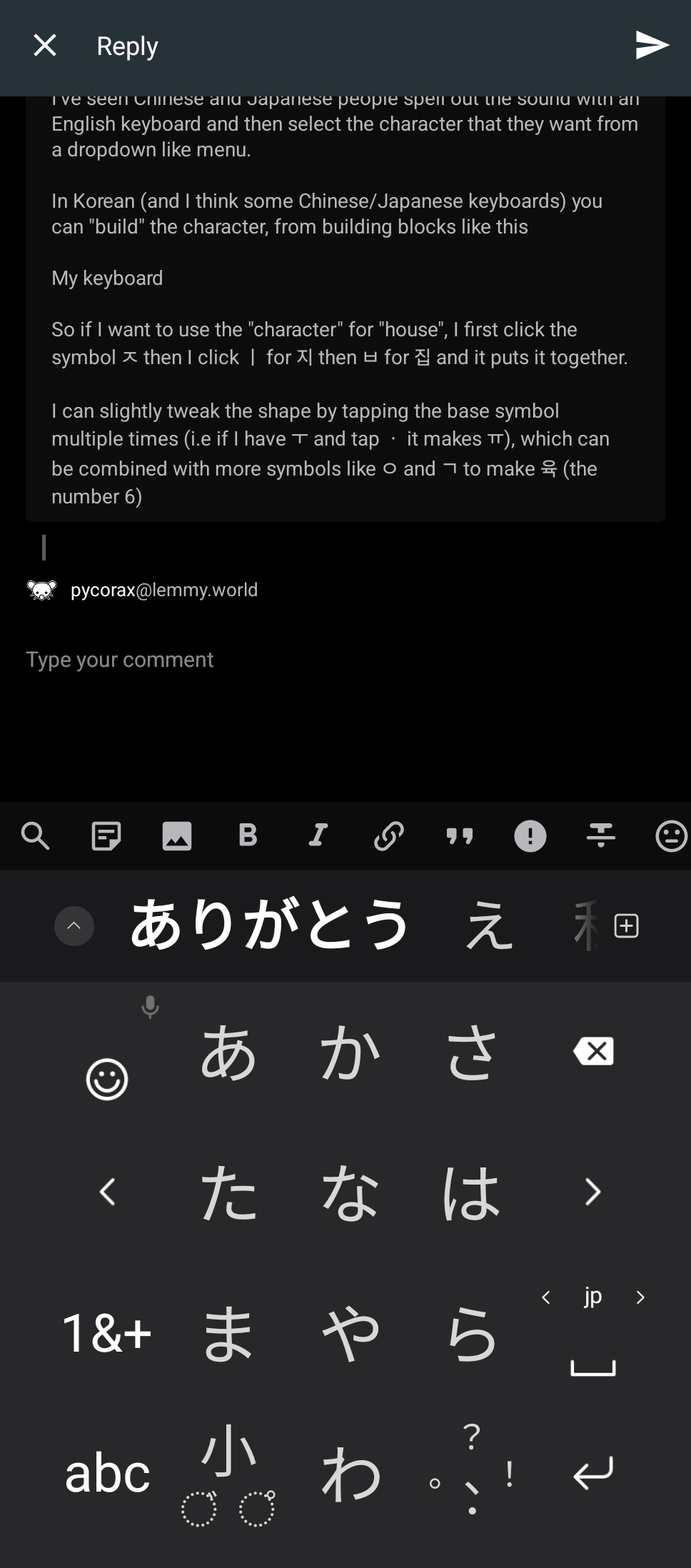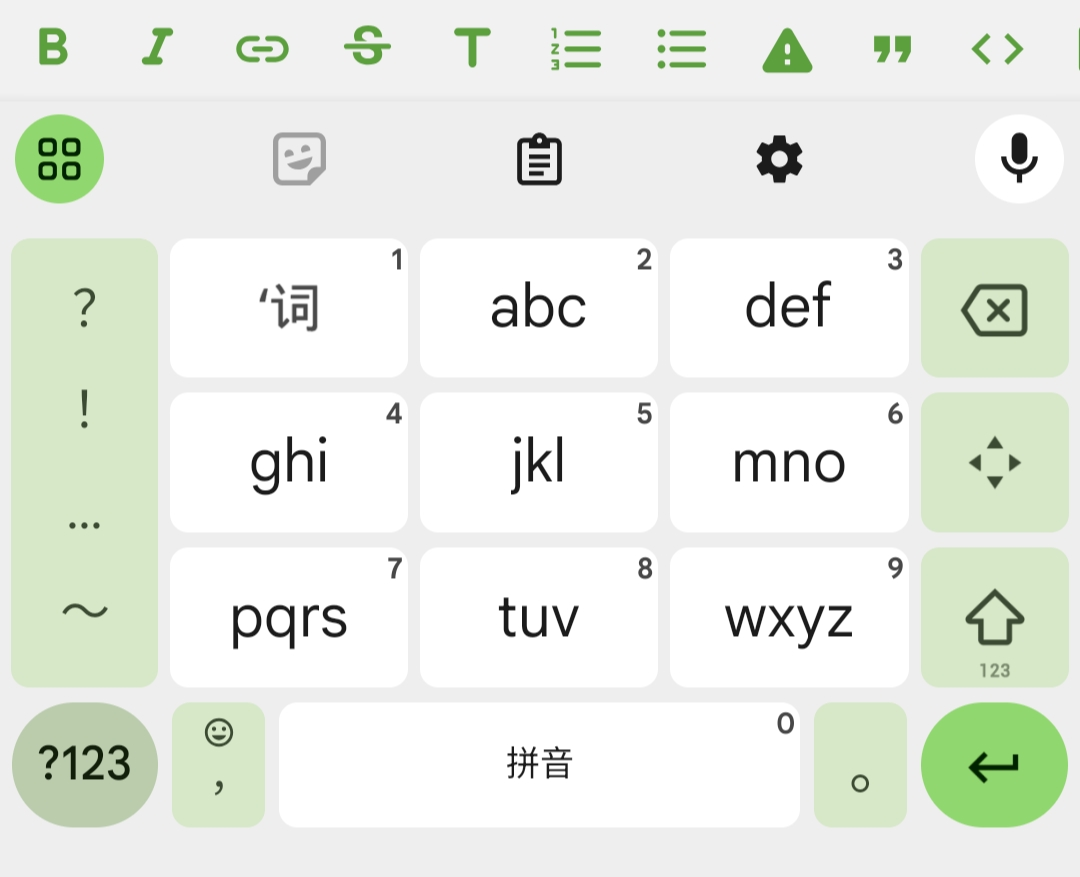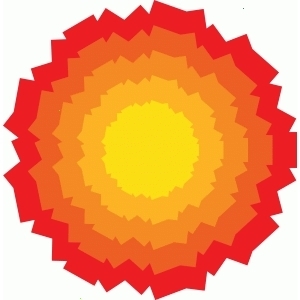So, if the Chinese don’t have an alphabet and use only pictograms comprising of over 6500 characters, how do they type on a keyboard? Do they have really large keyboards with over 6500 keys or do they just say “Screw Mandarin” and type in English (which can’t be true because I’ve seen Chinese characters on webpages/spam emails)? Is there some kind of algorithmic key pressing magic that goes on in order to produce said characters?
Chinese characters’ pronunciations are expressed using the Latin alphabet with accents for tone (for example tóng xué for 同学, or classmate). Therefore modern Chinese typing is done via normal Latin keyboards by typing the pronunciation (without tones because that’s a pain) and choosing between the keyboard’s different guesses for what you intended to write. For example to say “I want a cake” I’d type “woyaogedangao” and get 我要个蛋糕. This is the Pinyin system, which is used in mainland China among others. Taiwan uses a different system and I don’t know how they type with it.
Source: Am learning Chinese.
How’s learning Chinese going? It’s a beautiful language I’d love to learn someday. I’m trying to learn Esperanto and Spanish. Any advice for someone learning a language?
You gotta interact with that language, both in spoken and written (the former is more effective but the latter is more accessible) forms. Of course studying grammar and vocabulary is important, but it’s in the end a stepping stone so you can comprehend native content. Admittedly I have no idea if there’s even something like native Esperanto content, but yeah that’s the gist of it. It’s also best if the content you’re consuming is something you actually enjoy. I for example learned English from memes on Facebook and then Reddit, and learned Japanese from anime and light novels. Something to take into consideration is the n+1 rule, which says that when consuming content of a language you’re trying to learn, you should pick something where you can generally understand all words except one in a sentence. This allows you to use context clues to understand unknown words and makes the whole process more effective.
Also something to note is that learning two languages at once is, in my experience, not a good idea. They’ll start mixing and pronunciation rules for one will leak into another and generally cause a headache that’s probably not worth it.
PS: I keep saying consume because I’m too awkward to talk to native speakers, but that’s also a good option from what I hear.
So, a half remembered Radiolab episode or maybe it was 99% Invisible talked about this. If I remember rightly they did consider changing it because it was so much quicker and easier typing in English and Chinese character set takes up a lot of storage which was a big deal in early computers. Until someone figured they could break down all the Chinese characters into a much smaller selection of base shapes. So you could make a character by pressing a small selection of keys. So it meant a much more manageable keyboard. I think it’s even resulted in quick Chinese typists being faster than English ones.
Maybe that’s what I was thinking of. The title is Wubi but I couldn’t remember the show.
That’s it!
Pinyin. They also have fancy keyboards with only 9 buttons and predictive text.
Is it like a stenotype?
Also a great way to install keylogging apps
Like gboard?
Like the ones sexy cyborg exposed before she was brought in for a tea chat
I’ve seen Chinese and Japanese people spell out the sound with an English keyboard and then select the character that they want from a dropdown like menu.
In Korean (and I think some Chinese/Japanese keyboards) you can “build” the character, from building blocks like this

So if I want to use the “character” for “house”, I first click the symbol ㅈ then I click ㅣ for 지 then ㅂ for 집 and it puts it together.
I can slightly tweak the shape by tapping the base symbol multiple times (i.e if I have ㅜ and tap ㆍ it makes ㅠ), which can be combined with more symbols like ㅇ and ㄱ to make 육 (the number 6)
Japanese is kind of similar. Although usually native speakers do not use an English keyboard. They use this:

Since Japanese has 5 vowels, each key here represents a consonant and can actually enter any of the 5 vowels by either tapping on it or flicking up, down, left or right on it. Once you’ve built the word you’re trying to write, you can tap on the auto suggested kanji or katakana or leave it as is in hiragana.
The exception is the bottom left and right keys which are for alternative consonants (I’m not sure the actual linguistic term) and punctuation which have fewer options but work similarly.
So if I’m writing the character for home, I’d flick the button toy he right of the emoji button left for い and then right for え. Once I have both hiragana characters, I just need to tap on the 家 character that appears above the keyboard.
Reminds me of whatever this is

T9
I was using a keyboard for it for a while a couple months ago but when back to a keyboard due to missing features.
In Korean (and I think some Chinese/Japanese keyboards) you can “build” the character, from building blocks like this
I’d say you’re not building the character, but typing in the characters one by one.
집, as you know from typing it, is three characters in one. All three components are distinct. They can’t stand alone, but that’s not much different than “c” not really being able to stand alone in English. (If we refer to the letter C, we often capitalize it)
In Japanese, people can easily type in Hiragana (their “alphabet”), and the Kanji can be suggested like with autocorrect. The sound is the same, but the visual is different.
Chinese is a different beast because they don’t have an “alphabet” of “letters” the ways that Korean and Japanese do.
(They’re not “alphabets”, but they do have elements that are much closer to letters than Chinese does)
Hangul doesnt work the same way since each character is a letter. The blocks are syllables and are automatic using rules.
There are a handful of methods of input pinyin is taught in China and Zhuyin is taught in Taiwan.
Pinyin is romanized and much easier to learn in my opinion but mashes similar sounds together in a confusing way that isn’t obvious. Zhuyin uses a Chinese derives writing system and is more accurate towards how it’s pronounced but a little more difficult to learn especially for foreigners.
There’s a good podcast episode, maybe overheard at National Geographic on the wubi method and why the creator thinks it’s the best. Essentially pre-pinyin this genius guy came up with another method of input that even today is the fasted way to input Chinese but not as easy to learn as pinyin. Pinyin also carries over some ideological baggage as China wants everyone to learn the same first language at least so the main method of learning and input is pinyin. This is annoying for dialect speakers who have to type pinyin even when the pronunciation is off like Sichuanese or not even the same language like Cantonese.
Personally pinyin is a genius system that makes the language very easy but it can also be too much of a crutch for foreigners.
Isn’t Pinyin a romanisation method, i.e. writing Chinese using the Latin alphabet instead of Chinese glyphs?
Yes!
Is it used also for communication? I only know it’s being used for transcription of official documents like passports or addresses.
It’s only to input characters no one writes only pinyin except for foreigners
Ah ok. Now I understand.
Sample Text:
同志们
这个外国人连一点中文的知识都没有
真是笨蛋
Video of me typing it: https://i.imgur.com/uPKBdJh.mp4
The text is a joke btw, don’t take it too seriously.
Edit: Thats Pinyin for Mandarin. For Cantonese, theres Jyutping.
点
This has to be a shower head, right? I bet the sentence is about cleaning oneself
The fact that I can understand a good part of that scares me
Now that they type out characters phonetically, a lot of people don’t remember Chinese characters any more, even though they can still mostly read them, which is starting to be a new problem over there.
There is over 20k characters and most people know or use like 2 or 3k of them. Educated Chinese know like 6k on average. And it seems every decade the number goes down.
Curious what it’s evolving into.
Illiteracy possibly. Almost certainly more people will be less able to read older texts.
If that’s going to happen anyway, they could do worse than adopt Pinyin or some variant of it. Or they might prefer something like Bopomofo if they don’t want to use Western characters for whatever reason.
Either way, any decision like that is likely to be 20-30 years away at minimum, and that’s assuming literacy rates start going down, which they might not. I doubt Xi gives it any thought at all.
Reading is easy. I have been in the US for over a decade, barely ever read chinese, still know how to read basic characters.
Its writing that is hard.
Its like, its easy to know what an artist is depicting when looking at art, but its hard to draw that same image from the top of your head. Chinese characters is basically art, complicated af.
Also, don’t worry about literacy rates. Schools in China be strict af, they make you memorize an entire story, word for word.
Is there some kind of algorithmic key pressing magic that goes on in order to produce said characters
The umbrella term for the software used for East Asian Language input is “Input Method Editor.” IMEs exist for languages besides CJK also, such as for Vietnamese. Wikipedia article: https://en.wikipedia.org/wiki/Input_method
I assume the same way I type in Japanese: regular qwerty keyboard and phonetically. Space key lets you change between characters
BTW this is a hard problems, and its one very effective way the government installs keyloggers on many people
Removed by mod
I don’t use Google. I deGoogled my life. Besides, if we just used Google for everything there would be no point communicating at all and thus no point in Lemmy. We could all just ask the Master Google questions, chat with it’s AI and stay locked in our bedrooms eating pizza sponsored by Google.
Removed by mod
And the point is that I’d rather talk to a human.
Just tried it on Ask Jeeves as you suggested. It wasn’t very helpful:
Which method are you talking about lol
Method? Idk my roommate for like 6 years was Chinese and he had a keyboard that he could switch between American English and Chinese. He showed me how it worked and the key caps all had a few Chinese symbols next to each English letter and he could cycle between them as needed. He wasn’t as fast typing in Chinese, but it was the only way for him to communicate with certain family as they couldn’t speak or read English at all.
When his mom visited her laptop also had a similar set up except on hers the English letters were smaller and the. Chinese symbols were bigger. I assume because she bought it in China or something.
See, now I’ve learned something that I wouldn’t get from Google.
I know those types. Was he Chinese not Taiwanese? He might be older then? Parents generation use those methods typically. Not romanized
We also get to discuss it as well










